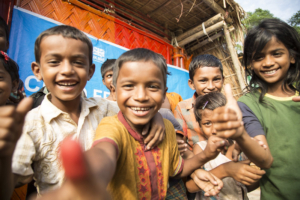5 Countries Supporting Foreign Aid
 In 2024, the world’s wealthiest countries donated $212 billion in foreign aid. Historically, foreign aid donations have mostly gone toward education, health care, sanitation and humanitarian assistance in developing countries. These donations are essential to growing the economies of donors and developing countries and helping people worldwide escape poverty. Here are five countries supporting foreign aid in 2025.
In 2024, the world’s wealthiest countries donated $212 billion in foreign aid. Historically, foreign aid donations have mostly gone toward education, health care, sanitation and humanitarian assistance in developing countries. These donations are essential to growing the economies of donors and developing countries and helping people worldwide escape poverty. Here are five countries supporting foreign aid in 2025.
Sweden
In April 2025, Sweden pledged $12.7 million to support Rohingya refugees in Bangladesh. More than one million Rohingya live in Bangladesh after fleeing violence and persecution in Myanmar. The package is funding sanitation facilities, food assistance and aid for victims of gender-based violence. Women and children account for more than 75% of the refugee population and in refugee camps, hygiene conditions are poor and malnutrition and abuse are rampant.
Sweden also backed Start Fund Bangladesh, an initiative empowering local organizations to respond quickly to emergencies. Additionally, in 2023, the nation helped fund the World Health Organization’s efforts in Ukraine, which provided care to 5.6 million people with noncommunicable diseases and emergency surgery and trauma care to 38,000 people.
Japan
Japan revised its foreign aid laws to improve efficiency in April 2025. The revisions allow the Japan International Cooperation Agency (JICA) to provide guaranteed reimbursement to banks in developing countries if borrowers do not repay loans. This helps banks continue to give loans to local businesses. The revisions also allowed JICA to help foreign businesses issue bonds to encourage investment. The changes focus on private sector development, a vital part of sustainable growth in developing countries.
Indonesia has maintained a longstanding partnership with Japan through the Official Development Assistance (ODA) program provided by JICA. Indonesia receives the most aid from Japan, with Japan providing 45% of the cumulative aid Indonesia has received since 1960. In February 2025, Japan worked with UNICEF Indonesia to bring nutritious meals and improved education to 2,500 children in schools across the Papua province of the country.
Slovenia
Slovenia sent two shipping containers full of school supplies, sports equipment and medical supplies to Madagascar in March 2025. Businesses, sports associations and the Olympic Committee of Slovenia provided the donations. The aid package followed the construction of a primary school in Antananarivo, the capital of Madagascar, by the nonprofit Caritas Slovenia. The construction began in September 2024, funded partly by the Slovenian Ministry of Foreign and European Affairs.
Education remains a significant challenge in Madagascar, with fewer than one-third of children enrolled through grade five. Only 17.5% achieve adequate literacy levels among those who complete grade five, highlighting the importance of the aid. Also in 2024, Slovenia sent $16.4 million of humanitarian aid to Ukraine and Palestine. On top of that, it gave $23.8 million to developing countries in the Western Balkans, including Serbia, North Macedonia, Bosnia and Herzegovina.
Italy
In March 2025, Italy announced a donation of $73.2 million to Syria. The aid package will support rebuilding after the fall of the Assad regime in December 2024, with focus areas including hospitals, infrastructure and food supply chains. About 43% of hospitals in Syria are not fully operational and 246 health facilities are at risk of closing due to bankruptcy. Additionally, nine million Syrians are food insecure, while the malnutrition rate in children has risen 3.1% since 2019.
Italy also continues implementing its Mattei Plan to support agriculture, education, health, energy and water access in several African countries, including the Democratic Republic of the Congo, Ivory Coast and Mozambique. In May 2025, Italy reaffirmed its collaboration with the African Development Bank as part of the Plan. The partnership aims to invest more than $400 million in private sector development in Africa over the next five years.
South Korea
South Korea sent Myanmar $4 million in aid after a 7.7 magnitude earthquake in March 2025. The aid provided the country with 500 tents, 40,000 water bottles and 80,000 blankets. The earthquake destroyed 55,000 homes and displaced 200,000 people.
In 2024, South Korea increased its foreign aid by $780 million compared to 2023, reaching $3.94 billion. This accounted for 0.21% of its gross national income, the highest level since joining the Development Assistance Committee (DAC) in 2010. Aiming to become a leading donor, South Korea is working toward entering the DAC’s top 10, currently ranking 13th. For 2025, it has allocated $4.7 billion to its foreign assistance budget.
These countries are leading the fight against poverty, ensuring foreign aid remains a policy focus in the future. Their efforts will continue to help millions of people.
– Tyler Payne
Tyler is based in Allentown, PA, USA and focuses on Global Health and Politics for The Borgen Project.
Photo: Flickr
